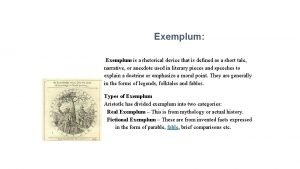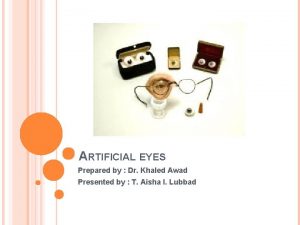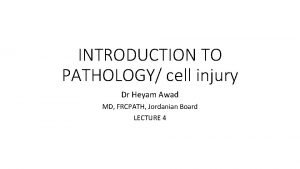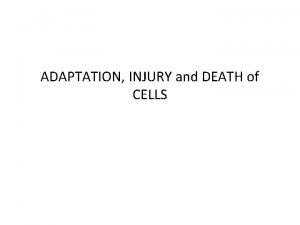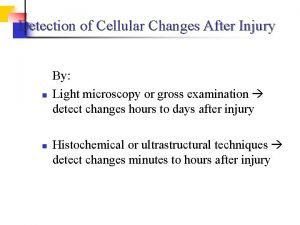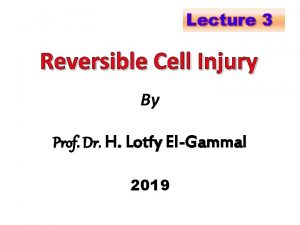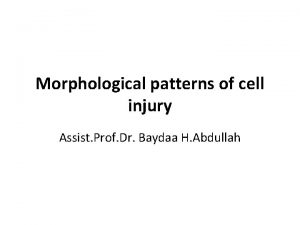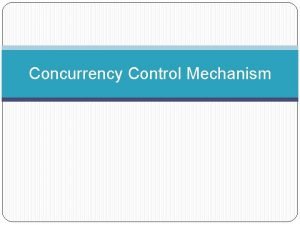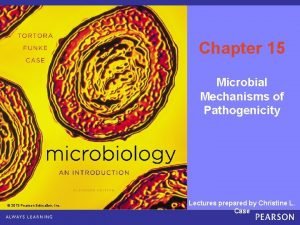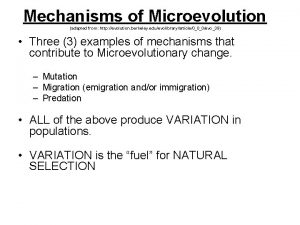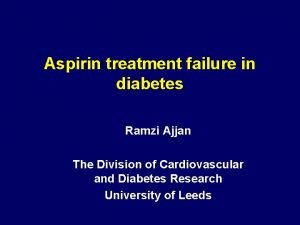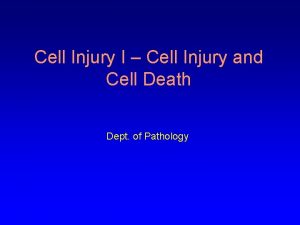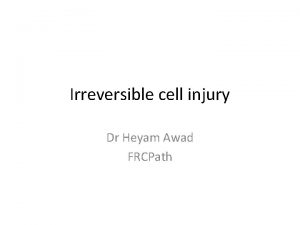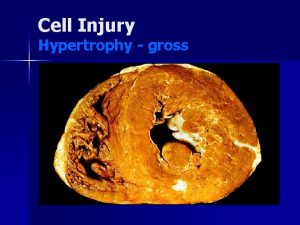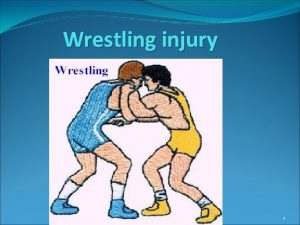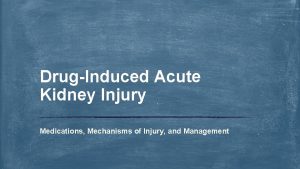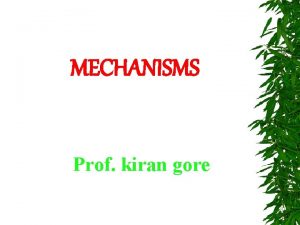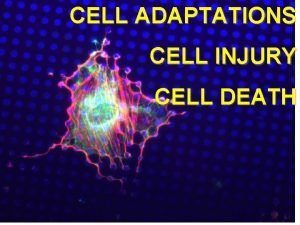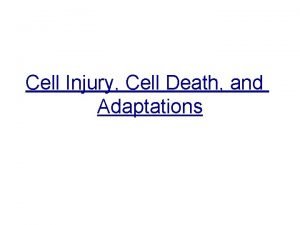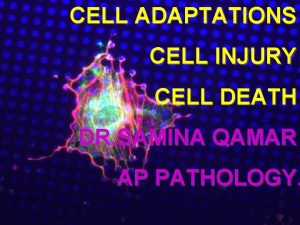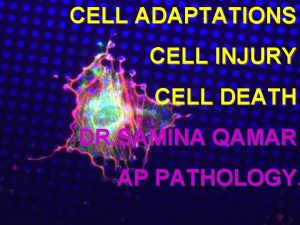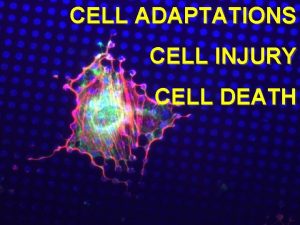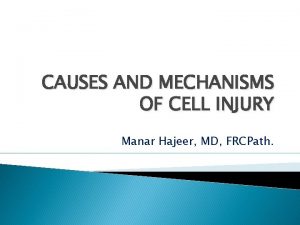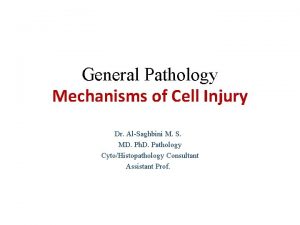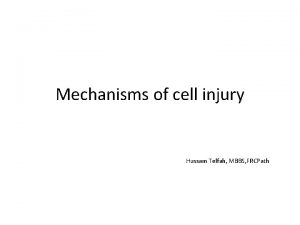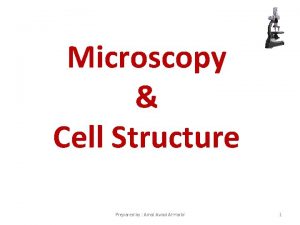Cell injury Dr H Awad Mechanisms of cell
































- Slides: 32

Cell injury Dr H Awad

• Mechanisms of cell injury


Mechanisms of cell injury • • • ATP depletion Mitochondrial damage Calcium influx Oxygen derived free radicals membrane defects Damage to DNA and protein

ATP depletion • • ATP. . Importance? Sources of ATP? Causes of depletion? Effects of ATP depletion?

Effects of ATP depletion • Membrane permeability affected due to effects on Na- K pump. • Increased acidity due to increased non oxidative phosphorylation. • Failure of calcium pump. . Increased intracellular calcium. • Structural disruption in protein synthesis apparatus. . Detacment of ribosomes and dissociation of polysomes

Mitochondrial damage • Failure of oxidative phosphrylation. . ATP depletion. • Abnormal oxidative phosphorylation. . ROS • Mitochondrial permeability transition pores. . Loss of membrane potentional and p. H change • Release of proteins that initiate apoptosis

Calcium influx • Activates enzymes… phospholipases, proteases, endonucleases, ATPases… so cell destruction. • Calcium can directly activate caspases… apoptosis

Oxygen free readicals • Definition? ? • Effect? ? • Formation? ?

Oxygen free radicals • Lipid peroxidation • Cross linking of proteins • DNA damage

Membrane permeability defects Caused by: Decreased phospholipid synthesis due to ATP depletion. Increased phospholipid breakdown. . Due to increased calcium ROS. . Lipid breakdown products

Irreversible injury • Two types? • Define each. .

Necrosis • Morphologic changes that follow cell death in living tissues.

NECROSIS • Denaturation of intracellular proteins. • Digestion of cells by lysosomal enzymes of dying cells ( autolysis) and leukocytes (heterolysis).

Apoptosis

Apoptosis • cell death induced by a tightly regulated suicide program in which cells activate enzymes capable of degrading the cells' own nuclear DNA and nuclear and cytoplasmic proteins. • Fragments of the apoptotic cells then break off, giving the appearance that is responsible for the name (apoptosis, "falling off"). .

apoptosis • The plasma membrane remains intact. • Apoptotic bodies (contain portions of the cytoplasm and nucleus) become targets for phagocytosis before their contents leak out and so there would be no inflammatory reaction.

Causes of Apoptosis • Physiologic situations: To eliminate cells that are no longer needed OR to maintain a steady number of various cell populations in tissues.

• Think of examples of physiologic apoptosis…

Physiologic apoptosis • Embryogenesis. • involution of hormone-dependent tissues upon hormone withdrawal. (endometrium and breast after pregnancy) • Cell loss in proliferating cell populations. (GIT) • Death of host cells after serving their useful function. (neutrophils and lymphocytes in inflammation) • Elimination of potentially harmful self-reactive lymphocytes. • Cell death induced by cytotoxic T lymphocytes (tumor cells and viraly infected cells)

Pathologic situations Examples: DNA damaged cells, . Cells with accumulation of misfolded proteins, Certain infections (viral ones): may be induced by the virus (as in human immunodeficiency virus infections) or by the host immune response (as in viral hepatitis). • Pathologic atrophy in parenchymal organs after duct obstruction (pancreas, parotid and kidney) • •

Morphology • Cell shrinkage: dense cytoplasm, tightly packed organelles. • Chromatin condensation: peripherally under the nuclear membrane. • Formation of cytoplasmic blebs • apoptotic bodies: blebbing then fragmentation into membrane bound apoptotic bodies composed of cytoplasm and tightly packed organelles with or without nuclear fragments.

Morphology • Phagocytosis of apoptotic cells or cell bodies by macrophages (quickly hence no inflammation).


• Draw apoptotic cell.

Mechanisms of Apoptosis • Activation of enzymes called caspases. • Two main pathways: • 1 - Mitochondrial pathway (intrinsic) • 2 - Death receptor pathway (extrinsic)

Mechanisms of Apoptosis • Activation of enzymes called caspases. • Two main pathways: • 1 - Mitochondrial pathway (intrinsic) • 2 - Death receptor pathway (extrinsic)

• 1 - mitochondrial pathway (intrinsic) • Leak of cytochrome c out of mitochondria and activation of caspase 9… • 2 - death receptor pathway (extrinsic) • Involved in elimination of self-reactive lymphocytes and in killing of target cells by some cytotoxic T lymphocytes. • Activation of caspase 8.


• What are the differences between necrosis and apoptosis? ? ?


Feature Necrosis Cell size Nucleus Enlarged (swelling) Reduced (shrinkage) Pyknosis → karyorrhexis → karyolysis Fragmentation into nucleosome-size fragments Plasma membrane Disrupted Intact; altered structure, especially orientation of lipids Cellular content Enzymatic digestion; may leak out of cell Adjacent inflammation Physiologic or pathologic role Frequent Intact; altered structure, especially orientation of lipids No Invariably pathologic (culmination of irreversible cell injury) Apoptosis Often physiologic, means of eliminating unwanted cells; may be pathologic after some forms of cell injury, especially DNA damage
 Awad examples
Awad examples Awad mataria
Awad mataria Khaled awad md
Khaled awad md Example of intentional injury
Example of intentional injury Myelin figures in reversible cell injury
Myelin figures in reversible cell injury Hypoplasia
Hypoplasia Types of cell injury
Types of cell injury Cell injury and inflammation
Cell injury and inflammation Mitochondrial swelling
Mitochondrial swelling Mucoid change in cell injury
Mucoid change in cell injury Cell injury and inflammation
Cell injury and inflammation Genetic causes of cell injury
Genetic causes of cell injury Managing weight and eating behaviors
Managing weight and eating behaviors Projection of feelings
Projection of feelings Synectics art
Synectics art Community based child protection mechanisms
Community based child protection mechanisms Concurrency control mechanism
Concurrency control mechanism Mechanisms of evolution
Mechanisms of evolution Synectic triggers
Synectic triggers Oral fixation personality
Oral fixation personality Chapter 15 microbial mechanisms of pathogenicity
Chapter 15 microbial mechanisms of pathogenicity 3 mechanisms of microevolution
3 mechanisms of microevolution Different file protection mechanisms
Different file protection mechanisms Vex iq gear ratio simulator
Vex iq gear ratio simulator Sponges defense mechanism
Sponges defense mechanism Weighing mechanisms in public forum debate
Weighing mechanisms in public forum debate Provider payment mechanisms
Provider payment mechanisms Defense mechanism
Defense mechanism Psychoanalytic theory defense mechanisms
Psychoanalytic theory defense mechanisms Displacement defense mechanism
Displacement defense mechanism Social control mechanisms
Social control mechanisms What is e-commerce mechanisms?
What is e-commerce mechanisms? Mechanisms of action of aspirin
Mechanisms of action of aspirin
